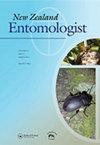Laboratory assessment of feeding injury and preference of brown marmorated stink bug, Halyomorpha halys Stål (Hemiptera: Pentatomidae), for Actinidia chinensis var. deliciosa ‘Hayward’ (Zespri® Green) and Actinidia chinensis var. chinensis ‘Zesy002’ (Zespri® SunGold)
IF 0.4
4区 农林科学
Q4 ENTOMOLOGY
引用次数: 8
Abstract
ABSTRACT The brown marmorated stinkbug (BMSB), Halyomorpha halys Stål (Hemiptera: Pentatomidae), is native to Asia and is characterised by its polyphagous feeding habits and high hitchhiking potential. In invaded areas, such as the eastern USA, economic damage to agricultural crops by BMSB has been significant. In northern Italy, where BMSB is invasive, feeding damage has been recorded in commercial kiwifruit orchards. In New Zealand, a major kiwifruit producer, BMSB originating from the USA, Italy and China (the native range of kiwifruit) have been intercepted. These BMSB interceptions pose a high biosecurity risk to key agricultural industries in New Zealand, including kiwifruit. However, information on the ability of BMSB to feed on key commercial kiwifruit varieties, and the types of damage it may cause to this crop, is lacking. To address this issue, Actinidia chinensis var. ‘SunGold’ (G3) and Actinidia deliciosa var. ‘Green’ (Hayward), were exposed to adult BMSB under no-choice and choice feeding trials. Across kiwifruit cultivars (i.e. Green and SunGold) and experimental setups (i.e. choice and no-choice), mixed adult groups (i.e. males and females feeding together) caused significantly more damage than individual females and males. After accounting for adult density, there was no experimental evidence that BMSB exhibited a feeding preference for either SunGold or Green varieties. However, there were variety differences for the development of BMSB feeding injury, with lower incidence of damage recorded for SunGold.褐纹臭虫Halyomorpha halys stapul(半翅目:Pentatomidae)对中国猕猴桃(Actinidia chinensis var. deliciosa ' Hayward ' (Zespri®Green)和中国猕猴桃(Actinidia chinensis var. chinensis ' Zesy002 ' (Zespri®SunGold)的取食伤害和偏好的实验室评估
摘要褐狨蝽(BMSB),Halyomorpha halys-Stål(半翅目:Pentatomicae),原产于亚洲,其特点是多食性和高搭便车潜力。在被入侵的地区,如美国东部,BMSB对农作物造成了严重的经济损失。在意大利北部,BMSB是入侵性的,商业猕猴桃园的饲养损失也有记录。在新西兰,一个主要的猕猴桃生产国,原产于美国、意大利和中国(猕猴桃的原生产地)的BMSB被截获。这些BMSB拦截对新西兰的主要农业产业,包括猕猴桃,构成了很高的生物安全风险。然而,关于BMSB以关键商业猕猴桃品种为食的能力,以及它可能对这种作物造成的损害类型的信息却很缺乏。为了解决这个问题,在无选择和选择性饲养试验下,将中华猕猴桃变种“SunGold”(G3)和美味猕猴桃变种“Green”(Hayward)暴露于成年BMSB。在猕猴桃品种(即Green和SunGold)和实验装置(即选择和不选择)中,混合成年组(即雄性和雌性一起进食)造成的伤害明显大于单个雌性和雄性。在考虑了成虫密度后,没有实验证据表明BMSB对SunGold或Green品种表现出喂养偏好。然而,BMSB饲养损伤的发展存在多种差异,SunGold的损伤发生率较低。
本文章由计算机程序翻译,如有差异,请以英文原文为准。
求助全文
约1分钟内获得全文
求助全文
来源期刊

New Zealand Entomologist
ENTOMOLOGY-
CiteScore
0.70
自引率
33.30%
发文量
3
审稿时长
>12 weeks
期刊介绍:
The invertebrate diversity of New Zealand is of great interest worldwide because of its geographic isolation and geological history. The New Zealand Entomologist plays an important role in disseminating information on field-based, experimental, and theoretical research.
The New Zealand Entomologist publishes original research papers, review papers and short communications. We welcome submissions in all aspects of science regarding insects and arthropods in a New Zealand or Australasian setting. The journal’s subject matter encompasses taxonomy, phylogenetics, biogeography, biological control and pest management, conservation, ecology and natural history.
The journal is the official publication of the Entomological Society of New Zealand. Papers published or submitted elsewhere for publication will not be considered, but publication of an abstract or summary elsewhere (e.g. conference proceedings) does not preclude full publication in the New Zealand Entomologist. Accepted papers become copyright of the Entomological Society of New Zealand. The journal is published in English, but we also welcome publication of abstracts in Maori.
 求助内容:
求助内容: 应助结果提醒方式:
应助结果提醒方式:


